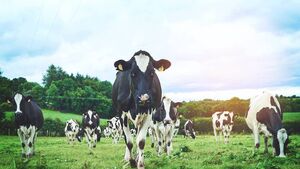Drop in Kildare farmland being sold will keep prices high

Land prices in Kildare are expected to remain high and may even strengthen in 2025
A significant drop in the supply of agricultural land for sale in Kildare will keep prices high according to a local auctioneer.
Paddy Jordan of Jordan Auctioneers offered insight into land prices in the annual farm survey by IPAV, the Institute of Professional Auctioneers & Valuers (IPAV).
Mr Jordan said: ‘The supply of land for sale in Co Kildare has dropped significantly with only around 1,400 acres sold last year compared to 4,500 acres ten years ago in 2013 (Farmers Journal Land Reports).
‘The rental market has also seen a decline in availability, largely due to the popularity of long-term leases over the past decade, which has reduced turnover.
‘Land prices are expected to remain high and may even strengthen in 2025, driven by limited supply and the deep-rooted desire in Ireland to own land.
‘Despite no direct correlation between price and return, demand remains strong, particularly from hobby farmers and successful businesspeople who see land as a secure investment. The perception of land as a ‘safe haven’ asset ensures that prices will stay elevated.’
In 2024 farm sales in Leinster was “a tale of two regions”.
Auctioneers in the northern part of the province report a good supply of land and a lively market whereas auctioneers in the southern counties saw supply remain static or tighten.
Traditionally tillage farmers were major players in the Leinster land market, but dairy farmers are undoubtedly in the ascendant along with business buyers, many of whom have a farming background who see land as a solid investment.
While a rough overall average price for land in the province comes to €16,259, grazing land made an average of between €13,300 and €20,000 per acre while some headline sales saw land make up to €36,000 per acre.
Forestry ground made an average of about €7,000 per acre while the lease price being paid for grazing land averaged between €245 and €400 per acre. Tillage ground commanded, on average, between €275 and €340 per acre.’ Nationally land sale and rental prices continue, according to the annual farm survey by IPAV with some regions expecting growth of 5% to 10% in 2025.
The average price for an acre of agricultural grazing land reached €13,949/ac in 2024, up 8% from €12,840/ac the previous year.
The average price for forestry land rose 7.8% to €6,407 per acre from €5,940 while the average price for letting land by con-acre stood at €268.
Long-term grazing leases averaged €299/ac and tillage came in at €304 per annum per acre.
The report says that a combination of higher farm incomes, a shortage of land and increasing demand from both farmers and investors drove prices. Farmers made their presence felt in the land market, especially in the last quarter, and were happy to go toe-to-toe with business buyers and investors in the auction rooms.
Predictions are that while macroeconomic uncertainties exist, the overall strength of Ireland’s agricultural sector suggests that demand for land will continue to rise. Consequently, land prices are expected to follow suit, with a broad consensus among IPAV members that land prices will remain strong, with some regions expecting growth of 5% to 10%.
Pat Davitt, IPAV’s Chief Executive says supply has been constrained by traditional factors such as farmers wanting to keep land in the family and newer trends such as the movement towards long-term leasing and the increasing footprint of solar farms.
“At the same time competition has intensified with the forthcoming Nitrates Directive, and increasingly land being viewed as a tax efficient vehicle for wealth transfer,” he said. “Beyond that there are of course regional factors that vary across the provinces.” Addressing forestry, he said prices are still rising but the reality is, farmers and investors bear many risks, trees may not reach maturity with exposure to fire and wind damage, “which we saw to devastating effect in the recent storm.” And he warned that unless some form of subsidy is introduced for the second and further plantations it will be very difficult to encourage farmers and investors to buy into additional forestry.
“Recent storms wrecked many forestry crops, and the price paid for timber by sawmills has dropped dramatically due to the availability of so much windblown timber,” he said. This will leave the price of forestry land struggling and will likely cause the government programme of planting trees to come close to standstill, he predicted.





